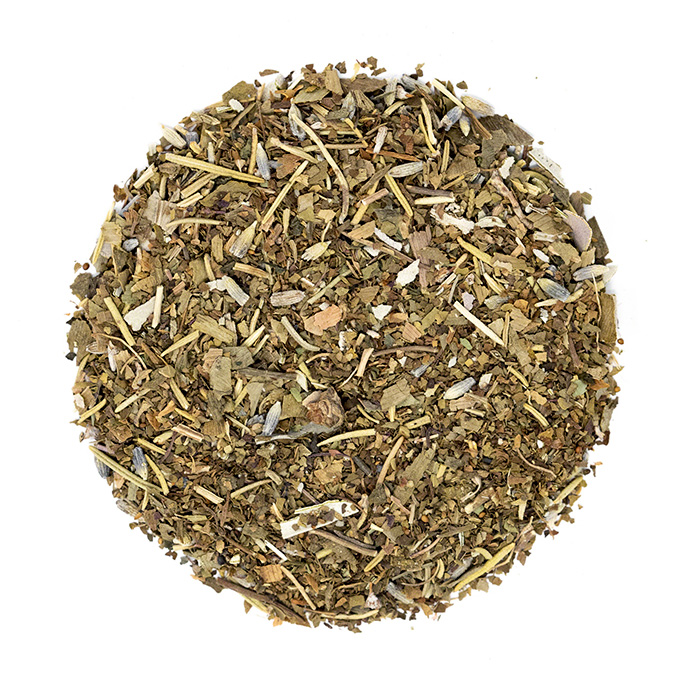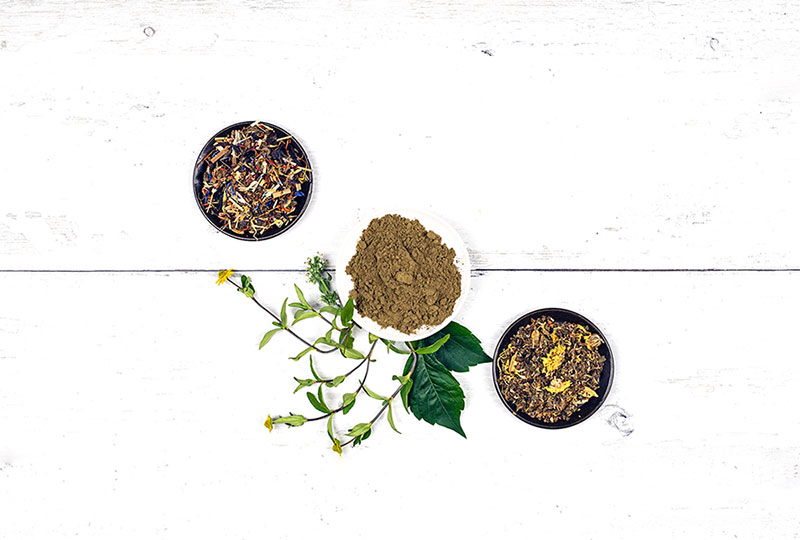Holy Basil Tea: Health Benefits + Easy Recipe
Unique, indispensable, holy and amazing – Holy Basil comes with many descriptions, and all of them are well earned. In fact, there aren’t many other plants in the world that could match the versatility, benefits and character of Holy Basil. If you love basil, you may love Holy Basil tea too. Read what makes it so special, what are the potential benefits and how to make a perfect cup of Holy Basil tea.
What is Holy Basil tea?
Holy Basil or Tulsi tea is a herbal, caffeine free tea made from Ocimum tenuiflorum or Ocimum Sanctum. It belongs to the same botanical genus as the regular culinary basil. And indeed, regular basil and holy basil are somewhat alike. However, unlike the regular basil that’s mostly used for cooking, holy basil is mostly used for its healing properties. It’s been known in herbal Ayurvedic medicine for thousands of years. This plant is native to India and considered sacred and indispensable. It’s found in many Hindu homes and has a religious importance as well.
Holy Basil vs tulsi tea?
Holy Basil or tulsi tea are the same herbal teas. In Hindi, the word tulsi means basil. In tea blends, the word tulsi is more often used than the word holy basil. The other names are Tulasi and the Queen of Herbs. However, there are different tulsi cultivars, such as Rama Tulsi, Krishna Tulsi and Amrita Tulsi[1]. Therefore, next time you see different colors of tulsi powder, it could be they were made of different cultivars.
Health benefits of drinking Holy Basil tea
Holy Basil may provide numerous potential health benefits. It belongs to a group of adaptogens. Adaptogenic teas may help reduce all types of stress naturally. This makes them a great addition to a tea cupboard, especially for all those moments when you need to relax with a cup of delicious caffeine free tea. Tulsi contains Vitamin A and C, calcium, zinc, iron and chlorophyll and many other beneficial organic compounds such as eugenol.[2] Except for helping with stress management, Tulsi has anti inflammatory, antioxidant, antidiabetic, anticancer, antimicrobial and radioprotective properties[3]
1. Detoxication and boosting immune system
Studies showed that tulsi may help protect organs against genetic, immune and cellular damage caused by environmental and chemical sources – such as pesticides, chemicals and medications[4]. Furthermore, red tulsi or Krishna Tulsi may have a better antioxidant capacity than white tulsi[5].
2. Protecting against infections
Not only may tulsi help protect against different viral, bacterial and fungal infections, but it may also help treat numerous infections too – from skin and wounds to viral and fungal[6].
3. Relieving symptoms of cold and treating respiratory diseases
What’s special about tulsi tea is that you may notice the benefits straight after drinking it. It may help to relieve cold, sneezing, cough, malaria and dengue immediately[7]. It’s often used as a natural remedy for asthma and bronchitis[8].
4. Stress management a fighting depression
Studies showed that tulsi may help fighting psychological and immunological stress. It may be a great natural companion in fighting depression. In fact, tulsi may even provide the same effect as antidepressants[9].
5. Enhancing memory
Tulsi may be beneficial for enhancing memory and help managing early stages of some cognitive disorders, such as Alzheimer’s disease[10]. It may also enhance the short-term memory and attention in healthy people[11].
6. Treating diabetes
Traditionally, tulsi has also been used for treating type 2 diabetes. Holy Basil leaf extracts may significantly lower blood sugar levels[12]. Furthermore, it may significantly lower blood pressure and blood fat as well, making it potentially a great herb for managing metabolic syndrome[13].
Are there side-effects of drinking tulsi tea?
If you are thinking of drinking tulsi to help deal with stress or depression, you don’t need to worry about getting addicted. Tulsi may create a sense of calmness and balance, without causing addiction[14]. However, just like with any other herb or plant, side-effects are possible, but very rare. One study reported nausea to be the main side-effect of taking tulsi[15]. Some other adaptogens may potentially have more side effects than tulsi.
How to make Holy Basil tea
Holy Basil is available in different forms – as loose leaf tea, powder or as holy basil extract supplements. Holy Basil leaves are used for making essential oil too. For making tea you can use both loose tulsi leaves or tulsi powder. Depending on which type you use, your tea will have a slightly different flavor. Tulsi is caffeine free.
Making tulsi powder tea
To make a cup of tulsi powder tea, use about 1/3 to ½ teaspoon of powder per cup of water. Bring water to a boil and steep in about 1/3-1 cup of water. Stir until dissolved. Tulsi powder gives a very strong, aromatic and dark cup of tea. Tulsi powder is a great choice if you want to add it to smoothies or even make Holy Basil lattes. However, drink it while hot as the powder will settle on the bottom and possibly have a slightly bitter flavor.
Making tulsi loose leaf tea
Tulsi loose leaves tea can be made from both fresh and dry tulsi leaves. While fresh tulsi may not be widely available, dry tulsi leaves can be bought from many specialized shops. Leaves can be unbroken or broken. Regardless if you are using fresh or dry leaves, always use fresh spring water for making tea. Use about ½ to 1 teaspoon of tea leaves per cup of water. Bring water to a boil. Steep the leaves covered for at least 5 minutes. The longer you brew them, the stronger the flavor you will get. Longer brewing will also allow more beneficial compounds to be extracted into your cup. Tulsi tea is yellow-green and has no bitterness. However, expect strong, basil-like flavor.
Best tulsi blends
If you are looking for a cup of aromatic, caffeine free tea to enjoy before sleep, tulsi blends may be a wonderful choice. Not only do they contain this amazing herb, but other soothing, calming or delicious ingredients too.
- Shanti Herbal with tulsi, saffron, fennel seeds and licorice is a blend created to offer a relaxation. It has a sweet and herbal flavor and zero caffeine.
- Holy Detox with tulsi, rosehips, spearmint, linden flowers and lemon myrtle
- Clari’tea with tulsi, ginkgo, white sage, gotu kola, lavender and rosemary
- PITTA Ayurvedic tea with chrysanthemum, raspberry leaves and tulsi
- Tulsi Chai blend with the same spicy, warming and bold flavor enhanced with tulsi leaves

Clari’tea herbal tea with white sage, tulsi, gingko, rosemary, lavender and gotu kola
Disclaimer: This article is for informational purposes only. It’s not intended to replace medical advice, diagnosis or treatment. Every person is different and may react to different herbs and teas differently. Never use teas or herbs to treat serious medical conditions on your own. Always seek professional medical advice before choosing home remedies.
References:
[1] https://blog.strictlymedicinalseeds.com/tulsi-holy-basil-type-comparisons/
[2] https://www.ncbi.nlm.nih.gov/pmc/articles/PMC3249909/
[3] https://www.ncbi.nlm.nih.gov/pmc/articles/PMC5376420/
[4] https://www.ncbi.nlm.nih.gov/pmc/articles/PMC4296439/
[5] https://rdo.psu.ac.th/sjstweb/journal/29-5/0125-3395-29-5-1407-1415.pdf
[6] https://www.ncbi.nlm.nih.gov/pmc/articles/PMC4296439/
[7] https://www.researchgate.net/publication/315119094_Tulsi_A_holy_plant_with_high_medicinal_and_therapeutic_value
[8] http://www.ijlpr.com/admin/php/uploads/266_pdf.pdf
[9] https://www.ncbi.nlm.nih.gov/pmc/articles/PMC5376420/
[10] https://www.ncbi.nlm.nih.gov/pmc/articles/PMC5376420/
[11] https://www.ncbi.nlm.nih.gov/pmc/articles/PMC5376420/
[12] https://www.ncbi.nlm.nih.gov/pmc/articles/PMC3454204/
[13] http://www.informaticsjournals.com/index.php/jnr/article/view/38





